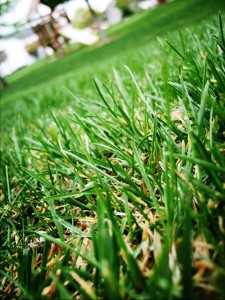
Understanding different types of grass
In the South one of the most common types of grass seed is Bahia. This grass is tough and is able to withstand high temperatures and heavy foot traffic. Bahia grass exhibits its best growth in coastal areas. A common choice for homeowners who experience weeds in their yard is Bermuda grass. Bermuda grass grows aggressively and can combat weeds that will attempt to spring up. Unfortunately, this type of grass can quickly spread into flowerbeds, so if you have a flower bed in your lawn you may want to consider a different variety of seed, or at least be prepared to spend a lot of time keeping the grass out of your flowers!
Bluegrass is one of the most popular choices throughout the United States. This grass requires moderate to heavy sun exposure, as well as regular watering and healthy soil. Bluegrass is a cool season grass that grows densely. Centipede grass is a great choice for homeowners who do not have a lot of time to devote to lawn maintenance. This grass is tough in texture, but weeds and pests have an especially hard time invading lawns with this type of grass. Centipede grass is most commonly found in the South.
Because of its high heat tolerance and notable winter resistance, Fescue grass is also one of the most popular choices in the country. Fescue grass generally grows best with infrequent irrigation–if over-watered, there are many types of diseases that can cause problems for fescue grass.
These are just a few of the most common types of grass seeds that are planted around the country. Other popular choices include:
-
Bent grass
-
Carpet grass
-
Rye grass
-
St. Augustine grass
-
Zoysiagrass
-
Buffalograss
-
Paspalum grass
These types of seeds vary in price dramatically. Rye grass, for example, can be found for as cheap as a dollar per pound, whereas paspalum grass can be as high as $45 per pound. And while you may think that all seeds are created equal, it’s important to not skimp on price when it comes to grass seed. A high quality grass will yield much better results.
Planting seeds
Many homeowners are intimidated by the effort required in planting grass seed in their yard. It may seem like a lot, but grass planting doesn’t require as much as you may think. Seeds can be planted in your yard in six easy steps:
-
Till – By breaking up the soil in your lawn, you allow for the seeds to easily access the earth.
-
Fertilize – Proper fertilization is one of the most important steps in ensuring a healthy lawn. Follow directions that come with the fertilizer you choose so that you can avoid over- or under-fertilization.
-
Distribute – Spread the seeds through the lawn. In small yards this can easily be done by hand, but for larger jobs it is recommended that that you use a seed spreader.
-
Protect – Once your seeds have been distributed cover them with a layer of hay or topsoil. This will protect the seeds from runoff or redistribution.
-
Irrigate – Water your seeds very gently during the early stages of growth. If watered properly your seeds will soon germinate and begin to sprout. If overwatered, your seeds may wash away before they have a shot.
- Defend – Once your seeds are ready for germination you need to begin defending your lawn. The seeds are fragile and easily disturbed at this stage, so try to keep people and pets off your lawn!